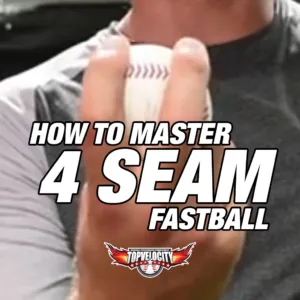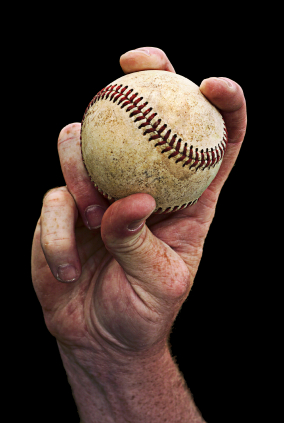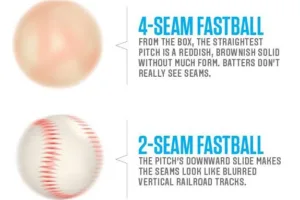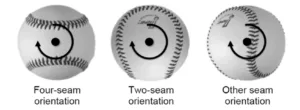 You're clearly entranced by the 4 seam fastball, a pitch that's become synonymous with baseball itself. It's a cornerstone in the pitcher's arsenal, captivating everyone from the Little Leaguers to the big league pros. Whether you're a greenhorn stepping onto the mound for the first time, eager to decode the basic mechanics, or a seasoned athlete striving to finetune your already formidable skills, rest assured that this article is your one-stop guide.
You're clearly entranced by the 4 seam fastball, a pitch that's become synonymous with baseball itself. It's a cornerstone in the pitcher's arsenal, captivating everyone from the Little Leaguers to the big league pros. Whether you're a greenhorn stepping onto the mound for the first time, eager to decode the basic mechanics, or a seasoned athlete striving to finetune your already formidable skills, rest assured that this article is your one-stop guide.
We're about to embark on an in-depth exploration that transcends mere fundamentals. This is not just about the grip or the throw; we're diving into the biomechanics, the science of spin rate, and even the role of technology in perfecting your 4 seam fastball. So get ready to elevate your game as we uncover the myriad aspects and little-known secrets that contribute to mastering this iconic pitch. Buckle up, because it's time to delve deep!
The Importance of the 4 Seam Fastball
The 4 seam fastball serves as the backbone of any pitcher's arsenal. It's straightforward but highly effective, capable of blazing through the strike zone with laser-like precision. To underestimate this pitch is to misunderstand its game-changing potential. It can be the bread and butter for many, setting up the plate for other specialized pitches.
How Do You Hold a 4 Seam Fastball
 Ah, the crux of the matter: How do you hold a 4 seam fastball? The grip is indeed foundational, and it's much more than just holding the baseball in a convenient or natural way. Several components come into play here—finger placement, thumb position, and the pressure exerted by both. Let's break it down, as nailing these elements can be the difference between an average throw and a lights-out, jaw-dropping 4 seam fastball.
Ah, the crux of the matter: How do you hold a 4 seam fastball? The grip is indeed foundational, and it's much more than just holding the baseball in a convenient or natural way. Several components come into play here—finger placement, thumb position, and the pressure exerted by both. Let's break it down, as nailing these elements can be the difference between an average throw and a lights-out, jaw-dropping 4 seam fastball.
Grip Basics: 4 Seam Fastball
At first glance, gripping a baseball might seem like second nature, but when it comes to a 4 seam fastball, it elevates into a craft. The grip is the linchpin that controls the baseball's trajectory, speed, and spin. An incorrect grip could make your pitch wobbly, slow, or simply off-target. Mastering the grip is paramount for anyone serious about their pitching game. We'll go over this in detail, examining the precise anatomical movements and adjustments that can turn you into a pro.
Finger Placement: 4 Seam Fastball
Your fingers are more than just appendages on your hand; they're the maestros orchestrating the pitch's every nuance. The exact placement of your fingers on the baseball seams will greatly affect your pitch's control and velocity. Too far apart, and you might lack control; too close together, and you could sacrifice speed. Learning the golden mean of finger placement is like learning the keys on a piano—essential for creating beautiful music, or in this case, a stunning 4 seam fastball.
Thumb Position: 4 Seam Fastball
Your thumb's role in this pitch is not to be underestimated. It's not just there for support; it's an active participant that influences the ball's release and spin rate. The thumb's position, whether tucked under the ball or aligned along a seam, can dramatically affect the flight of your 4 seam fastball. We'll delve into the biomechanics of thumb placement and how slight shifts can transform the efficacy of your pitch, adding the much-needed spin or control.
So there you have it, a comprehensive look at the art of gripping a 4 seam fastball. Each element—finger placement, thumb position, and grip pressure—comes together like a well-orchestrated symphony to deliver that game-changing pitch. Mastering these can make the difference between being a good pitcher and a great one.
Getting the 4 Seam Fastball Spin Rate Right
 Spin rate isn't just a flashy term thrown around by commentators; it's a critical element that can make or break your 4 seam fastball. It's the magic behind the pitch's ability to defy gravity for just a moment, making it harder for batters to hit. Let's explore the factors that contribute to achieving the ideal spin rate, including the role of the baseball's seams and how modern technology like high-speed cameras can provide invaluable insights.
Spin rate isn't just a flashy term thrown around by commentators; it's a critical element that can make or break your 4 seam fastball. It's the magic behind the pitch's ability to defy gravity for just a moment, making it harder for batters to hit. Let's explore the factors that contribute to achieving the ideal spin rate, including the role of the baseball's seams and how modern technology like high-speed cameras can provide invaluable insights.
Role of Seams: 4 Seam Fastball
The seams on a baseball aren't just for aesthetics; they play a fundamental role in determining the flight of the ball. As the ball hurtles through the air, the seams interact with the air resistance, affecting not just the ball's trajectory but also its speed and late break. Seam orientation and the spin generated through grip and release directly affect how much "life" your fastball will have. Understanding the intricate dynamics between seam orientation and air resistance can provide you a tangible advantage, making your 4 seam fastball not just fast but elusive. We'll delve into strategies to master this seam interaction, incorporating aerodynamics principles that could make your fastball the ace up your sleeve.
 High-Speed Cameras and Spin Rate: 4 Seam Fastball
High-Speed Cameras and Spin Rate: 4 Seam Fastball
As they say, "what gets measured gets managed," and nothing helps you measure the minutiae of your 4 seam fastball like high-speed cameras. These cameras, capable of capturing thousands of frames per second, can give you an almost microscopic look at the spin rate and seam orientation during the pitch. These metrics are more than just numbers; they provide a deep understanding of how slight adjustments in your grip or release can significantly impact the ball's behavior. Coaches and players are increasingly leaning on this technology to refine their techniques, making data-backed decisions that contribute to mastering the 4 seam fastball.
When you combine the knowledge of seam interaction with precise data from high-speed cameras, you're essentially equipping yourself with a scientific edge. It takes the guesswork out of the equation, allowing you to focus on perfecting the elements that contribute most to a potent 4 seam fastball. So, the next time you step onto the mound, remember that mastering spin rate through seam manipulation and technology can set you apart in the art of pitching.
Mechanics of Throwing a 4 Seam Fastball
 It's crucial to understand that holding a baseball with the correct grip sets the stage, but it's just one act of a much larger play. The mechanics of your body during the pitch — your arm angle, release point, and follow-through — are equally, if not more, important in mastering a 4 seam fastball. So, let's get into the biomechanics of this classic pitch and how you can elevate your game to the next level.
It's crucial to understand that holding a baseball with the correct grip sets the stage, but it's just one act of a much larger play. The mechanics of your body during the pitch — your arm angle, release point, and follow-through — are equally, if not more, important in mastering a 4 seam fastball. So, let's get into the biomechanics of this classic pitch and how you can elevate your game to the next level.
Arm Angle: 4 Seam Fastball
Your arm angle isn't merely about aesthetics or comfort; it fundamentally shapes the ball's path from your hand to the catcher's mitt. An optimal arm angle helps you harness the power of biomechanics, allowing you to generate the maximum amount of velocity and spin rate. Each pitcher will have a slightly different "sweet spot," given their unique body mechanics, but there are general principles. For instance, a high arm angle could produce a pitch that drops less, giving the illusion of rising as it reaches the plate. Conversely, a lower arm angle could generate more horizontal movement. Discovering your optimal arm angle isn't just about experimentation; it's about keen self-awareness and possibly even consulting biomechanical experts to fine-tune your throw.
Release Point: 4 Seam Fastball
The release point is the critical moment of truth in any pitch, but especially so in a 4 seam fastball where control and speed are paramount. Consistency is the key. Variability in your release point often leads to a lack of control, turning what could have been a strike into a ball or, worse, a home run for the opposing team. A consistent release point not only enhances your control but also makes it harder for batters to predict the pitch type and location. Work on your release point through targeted exercises, and you'll find that strikes come much more naturally.
Follow-Through: 4 Seam Fastball
The follow-through is often the most overlooked aspect of pitching, but it's the capstone that can either enhance or diminish the effectiveness of your 4 seam fastball. A proper follow-through ensures that you've transferred all of your body's built-up energy into the pitch, maximizing velocity and spin while also reducing stress on the arm. A truncated or inconsistent follow-through can lead to decreased performance and increased risk of injury. Learning the art of a skillful follow-through is like mastering the period at the end of a sentence; it finalizes your effort and leaves a lasting impression on the result.
By combining these mechanical principles with a solid understanding of grip and spin rate, you're well on your way to mastering the 4 seam fastball. And remember, it's not just about throwing hard; it's about pitching smart.
3X Drills to Improve 4 Seam Fastball Skills
Improving your 4 seam fastball is about more than just grip and body mechanics. Specific, targeted drills can help fine-tune your technique and propel your fastball to the next level. Here are two innovative 3X drills designed to help you hone in on the specific skills needed for a powerful and accurate fastball.
3X Target Throw Open Full Stride
In this exercise, you start in a full stride position, which is about 80-90% of your height from heel to toe. Your objective is to practice initiating the triple extension from the front foot strike, thereby enabling better linear energy transference to the trunk. This movement pattern helps you generate more velocity while reducing arm stress.
The Breakdown:
- Starting Position: You begin with your weight loaded into your back hip, chest open, and glove tucked.
- Lift and Fall: Perform some dry lifts, falling forward and down simultaneously, triggering the triple extension just before your front foot lands.
- Back Hip Drive: As you stride, emphasize the drive from your back hip. This ensures that your energy flows sequentially from your hip, to your trunk, and finally to your arm.
- Stabilize and Launch: Once the front foot lands and stabilizes, allow your trunk to launch forward, followed by arm rotation and ball release.
Key Point:
If your pitch is deviating left to right, it likely means you're adding undue rotational force. Strive for the ball to deviate vertically (up or down) instead.
3X Target Throw Separation Full Stride
This drill focuses on creating separation between your hip and shoulder, allowing for a stronger and more coordinated linear drive. This separation is crucial for optimizing the kinetic sequence of the throw, which is hip-trunk-arm.
The Breakdown:
- Starting Position: Your feet are straight and parallel, about 80-90% of your height apart. Your hips are slightly open.
- Lift and Drive: From this position, lift your front leg and drive forward with your back hip, making sure your feet are straight to facilitate hip rotation.
- Shoulder Rotation: Once your front foot lands, it's time to engage the upper body. Your shoulder should rotate and abduct, creating separation from your back hip.
- Follow Through: As your trunk launches forward, your front leg should extend back to support and accelerate your energy into arm rotation and ball release.
Key Point:
Maintain a contralateral trunk position for additional power and accuracy. As you drive your back hip forward, your trunk should mirror this movement but in the opposite direction.
By consistently incorporating these drills into your training regimen, you'll be well on your way to mastering the 4 seam fastball. Remember, like any finely tuned machine, your body requires regular, targeted maintenance to perform at its peak.
Elevate Your Game with TopVelocity's Patreon Pro Membership
 If you're serious about taking your pitching skills to the next level, there's no better investment than TopVelocity's Patreon Pro Membership. With years of experience and cutting-edge research behind our techniques, TopVelocity has a proven track record of creating elite athletes while minimizing the risk of injury. Now, with our Patreon Pro Membership, you get exclusive access to an even more in-depth level of training, personalized to fit your needs.
If you're serious about taking your pitching skills to the next level, there's no better investment than TopVelocity's Patreon Pro Membership. With years of experience and cutting-edge research behind our techniques, TopVelocity has a proven track record of creating elite athletes while minimizing the risk of injury. Now, with our Patreon Pro Membership, you get exclusive access to an even more in-depth level of training, personalized to fit your needs.
What You Get:
- Video Analysis: Submit videos of your pitching form and receive detailed, personalized feedback from experienced coaches, giving you specific recommendations on how to improve your mechanics for both effectiveness and safety.
- Full Library of Instructional Videos: Unlimited access to an extensive library of instructional videos that covers every aspect of pitching—from the basics to the most advanced techniques.
How to Sign Up:
- Visit Our Patreon Page: Go to topvelocity.net/patreon.
- Choose the Patreon Pro Membership Tier: This tier will give you the full range of benefits, including video analysis and complete access to our instructional video library.
- Submit Your Information: After choosing the Patreon Pro Membership, you'll be prompted to submit your personal and payment information.
- Confirm and Become a Pro Member: Once you've confirmed your details, you'll officially become a Patreon Pro Member, unlocking a world of premium pitching resources designed to elevate your game.
Why Choose Patreon Pro?
- Personalized Feedback: The video analysis isn't a generic set of pointers; it's a personalized plan tailored to your specific mechanics and needs.
- Scientifically-Backed: All of our instructions and analyses are backed by the latest research in sports science, ensuring you're getting information you can trust.
- Community Access: You'll also become part of a community of like-minded athletes, all striving for excellence, in a space where you can share insights, ask questions, and get additional support.
Don't miss this unique opportunity to fine-tune your pitching skills with unparalleled access to the industry's top expertise. Sign up for TopVelocity's Patreon Pro Membership today and start your journey towards becoming an elite pitcher.
FAQs
- What is a 4 seam fastball? A 4 seam fastball is one of the most popular and fundamental pitches in baseball, known for its high velocity and straight trajectory.
- How do you grip a 4 seam fastball? The grip involves placing your fingers over the seams of the baseball and using your thumb for support underneath.
- How important is spin rate for a 4 seam fastball? Spin rate is crucial for a successful 4 seam fastball, as it affects the ball's movement and speed.
- Can young players throw a 4 seam fastball? Absolutely! The 4 seam fastball is often the first pitch taught to young players due to its simplicity and effectiveness.
- How can technology help me improve my 4 seam fastball? High-speed cameras, video analysis, and pressure sensors can provide invaluable data and insights to fine-tune your pitch.


 High-Speed Cameras and Spin Rate: 4 Seam Fastball
High-Speed Cameras and Spin Rate: 4 Seam Fastball